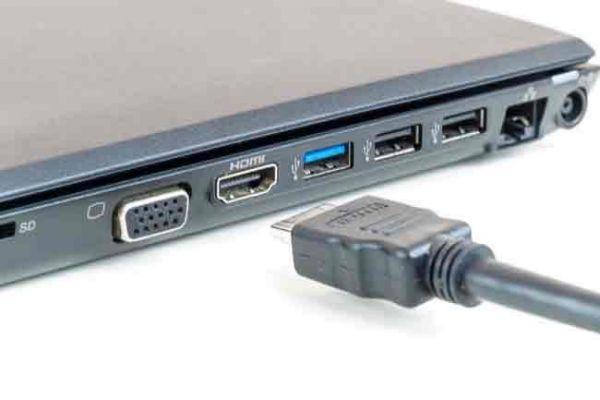
The easiest way to increase your laptop screen size. Quickly connect your laptop to your TV by connecting one end of the HDMI cable to your TV and the other to your computer. Make sure you change the HDMI input source on your TV to match the HDMI port you use.
You may need a specific HDMI adapter for your laptop model. This article explains how to connect a laptop to a TV using HDMI and, if necessary, an HDMI adapter.
- How to connect two monitors to a laptop
How to connect a laptop to a TV via HDMI
Connecting a laptop to a TV via HDMI is fairly straightforward, and hopefully should only take a few minutes to complete. Plug one end of the HDMI cable into your laptop's HDMI port.
If your laptop doesn't have an HDMI port, you'll need an HDMI adapter. The exact type will vary depending on the model of your laptop. You can also use a docking station or hub with an HDMI port. Connect the other end of the HDMI cable to the TV. Make sure you remember which port you use for your laptop's HDMI connection to the TV.
Using your TV remote, change the source on your TV until you get to the HDMI port you connected the HDMI cable to. The button name varies by TV model, but it's essentially the same one you use to switch between regular TV channels, your DVD player, and your video game console if you have one.
The laptop should automatically detect the connection and start mirroring to the TV.
How to switch from mirroring to extension
The default setting for a laptop-to-TV HDMI connection is to mirror the laptop screen to the TV. This basically just means that everything you see on your laptop screen will be shown on your TV screen at the same time.
An alternative setting is to have the TV act as some sort of extension or second screen that you can control from your laptop. This allows you to open files or apps privately on your laptop and show selected media to others on the TV screen.
To make this change on a Mac, open the Apple menu in the upper left corner and click System Preferences> Displays> Arrangement.
To switch from Mirror to Extend on a Windows 10 laptop, open Action Center by clicking on the square icon in the lower right corner or by swiping from the right side of the screen on a touch-enabled device such as Surface Pro. Click Project to view TV viewing options.
You can change your viewing preferences as often as you like.
- How to connect the computer to the TV with an HDMI cable
Troubleshooting when connecting a laptop to a TV via HDMI
Having trouble playing the picture or sound through your TV from your laptop? Here are some quick fixes worth trying.
1. Restart the laptop: Sometimes restarting the laptop with the HDMI cable connected can force the display to switch to the TV screen.
2. Check the HDMI port on your TV: The HDMI ports on your TV can often be very narrow and it's easy to think the cable has been connected when in reality the connection is barely made. Check firmly and carefully to make sure the cable is connected all the way.
3. Check the HDMI port on your laptop: Some laptops, such as some Surface Pro models, have curved edges that can cause HDMI adapters to disconnect. Make sure that all edges of the door are sealed and that the cable is not pulled out.
4. Check if the HDMI cable is not damaged: The HDMI cable may have been damaged during storage or moving.
5. Install the latest OS and firmware updatesWhether you own a Mac or a Windows laptop, downloading the latest updates can often solve many technical problems.
6. Double check the HDMI source: Your TV may be trying to read from the wrong HDMI port. Browse all your media sources on your TV with the remote.
7. Change HDMI ports: If you think an HDMI port may be damaged, try using a port that has been shown to work like the one connected to your Xbox or Blu-ray player.
Further Reading:
- How to connect the Nintendo Switch to the laptop
- The best adapters from HDMI to VGA
- How to connect Chromebook to the monitor
- How to connect monitor to laptop
- How to connect Chromebook to TV






